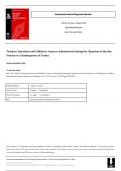Exam (elaborations)
Teachers' Questions and Children's Answers Administered during the 'Question of the Day' Practice in a Kindergarten of Turkey
- Course
- Institution
In Turkey, particular importance is given to pre-school education and free education in public schools provides equal opportunities. The objective is to increase the quality of preschool education in the country and to allow all children benefit from this education (MoNE Annual Report, 2018). T...
[Show more]



